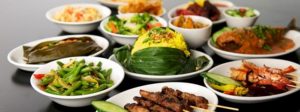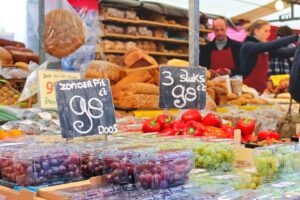You will be spoilt for choice when it comes to food in the Netherlands. For one, there are plenty of traditional Dutch dishes to sample. What’s more, as an expat, you might not miss the meals from your home country either! This is because there is so much international food on offer in Holland. Explore your culinary options on this page. We will also explain where you can find certain types of produce, and teach you how the Dutch feel towards their cuisine.
TYPICAL DUTCH FOODS
While there is a rich variety of international food available in the Netherlands, there is a basic, quintessential ‘Dutch cuisine’ too. It consists mainly of comforting, hearty and homely dishes!
Ten Top Temptations
Here is a list of the 10 most typical Dutch foods:
- ‘Erwtensoep’: Pea soup
- ‘Stamppot’: A mashed vegetable dish, consisting of ‘boerenkool met worst’. This is curly kale with sausage
- ‘Hachée’: Beef and onion stew
- ‘Zuurkool met worst’: Sauerkraut with sausage
- ‘Witlof met ham en kaas’: Belgian endives with ham and cheese sauce
- ‘Asperges met ham en eieren’: Asparagus with ham and eggs. This dish is traditionally served in May and June
- ‘Boterham met hagelslag’ or ‘Vlokken:’ A sandwich filled with chocolate sprinkles or flakes
- ‘Bitterballen’ or ‘Kroketten’: Small snacks made from finely minced meat and flower, formed into balls or oblong shapes
- Stroopwafels’: Fine waffles, filled with syrup
- ‘Haring’: Herring. The Dutch eat this raw, with chopped onions
Dutch meals
The Dutch usually only eat one hot meal a day. It can be served for lunch or dinner but, generally, it is the evening meal. A typical day of Dutch eating might look something like this:
Dutch Breakfast
- Breakfast may consist of fresh breads, or open-faced sandwiches
- Usually, the Dutch will use fresh bread from the bakery
- Dutch ‘rusks‘ are also popular. These are a kind of circular toasted biscuit, called a ‘beschuit‘
- Rolls, or croissants, topped with butter, jams, jellies, cheese, sausage or cold cuts are common too
Lunch in the Netherlands
- A Dutch lunch is usually quite similar to a Dutch breakfast
- It might include a small cup of hot soup, but this does not qualify as the hot meal of the day
- A mixed salad, or an ‘uitsmijter‘ are examples of common Dutch lunch items too
- An uitsmijter is a kind of hot sandwich. It is composed of two fried eggs on a layer of ham, roast beef and/or cheese, atop two slices of bread
- The meal is typically accompanied by milk, coffee or tea
- You may well find some fruit, or a ‘kroket‘ on the table as well. These meaty snacks are described in the paragraph above
Coffee time in the Netherlands
- Coffee and/or tea breaks are a sacred Dutch custom. They take place in the mornings and afternoons
- The beverages are served piping hot and often come with cookies
- Pastries or cakes might be served instead, if there is a special occasion to mark
The evening meal in NL
Before Dinner
- In the evening, the Dutch often like to have a ‘borrel‘ before dinner
- A borrel is a drink. It will usually be beer
- Snacks might be enjoyed with the beer, if a special occasion is being celebrated
- ‘Bitterballen‘ are a popular choice. They are little round croquettes
The Main Course
- Dinner tends to be the heartiest meal of the day
- Traditionally, it will be made up of vegetables, meat and a healthy serving of the ubiquitous Dutch potato
- They might come as a side dish, in the form of chips, or ‘patat frites‘ in Dutch, or they might be merely boiled or steamed
- Sometimes, the vegetables and potatoes will be mashed together to form a traditional Dutch ‘stamppot‘
- Stamppot is served with ‘rookworst‘, which is a type of smoked sausage
- Or, it might come with ‘draadjesvlees‘, which is simmered beef
Dutch Dessert
- The Dutch like to have some kind of dessert too. It will usually be yogurt
- Yoghurt comes in a variety of flavours in the Netherlands
- ‘Vla’ is another popular Dutch dessert. It is a kind of custard
- Fruit, or sometimes cheese, might come with pudding
- To accompany the meals, the Dutch usually stick to water, milk or soft drinks
- Wine tends to be saved for special occasions in the Netherlands
 Side Note
Side Note
Eating Out in NL
When the Dutch eat out, they like eat food that they wouldn’t usually cook at home. So, they tend to go for an: Indonesian, Italian, French, or Chinese meal.
Some Dutch culinary history
The Netherlands is host to a wide variety of different cuisines. How did this come about?
- The Netherlands is a former shipping and colonial power
- It was interested in Indonesia, South Africa and the Caribbean
- In the 16th century, Dutch explorers started to return from the orient with exotic spices
- Many people from these countries eventually came to live in the Netherlands too
- They were later joined by guest workers, from the Mediterranean
- The Netherlands started to become the hub of business interests in Europe
- This drew international businessmen and women to the Netherlands, along with their families
Culinary Consequences
- The consequence of all this is that international produce and spices have had an important place in the Dutch kitchen cabinet ever since
- Therefore, produce from all over the world is available in Dutch supermarkets to this day
- If you cannot find what you are looking for in Jumbo, almost all herbs and spices known to man are sold in Indonesian shops or ‘tokos‘
- Chinese supermarkets have fantastic selections of ingredients as well
INDONESIAN and CHINESE FOOD & SPICES
 There are over 900 Chinese and Indonesian shops in the Netherlands. Thus, it is safe to say that these cuisines are much-loved by the Dutch!
There are over 900 Chinese and Indonesian shops in the Netherlands. Thus, it is safe to say that these cuisines are much-loved by the Dutch!
- The Dutch call their Indonesian meal the ‘rijsttafel‘, meaning the ‘rice table’
- As you might have guessed, rice is the central dish of the rijsttafel! There may be as many as three different types on one table
- Several side dishes will be served up with the rice. They might consist of: fish, meat, poultry or vegetables
- The rijsttafel may be prepared at home, eaten at restaurants or carried home from Indonesian or Chinese takeout shops
Ethnic shops in NL
If you are missing dishes from your home country, you may well be able to find the ingredients to make them in the Netherlands. In big Dutch cities you will find shops specializing in foods, and other products, of specific ethnicities. For example, there is likely to be a:
- ‘Turkse slager’: A Turkish Butcher
- ‘Turkse winkel‘: A Turkish shop. This will sell products from Turkey and the eastern Mediterranean
- ‘Islamitische slager’: An Islamic butcher. This will sell halal meat
- Jewish Meat Market. You can only find this in Amsterdam. It sells kosher meat
- Amsterdam, Rotterdam and The Hague all have small Chinatowns
International Food in NL
You will be able to find either restaurants, or cooking ingredients, for the following cuisines in the Netherlands as well:
- Moroccan
- Japanese
- Indian
- Mexican. Most Dutch supermarkets actually have a small ‘Tex/Mex’ department
Supermarkets in the Netherlands
Dutch supermarkets carry all the basic groceries you are likely to need. Amongst many many other things, you will find the following items in a Dutch supermarket:
- Baking and cooking ingredients
- Dairy products, including cheeses
- Herbs and spices
- Baked goods
- Health foods
- ‘Exotic foods’. For example, Japanese, Moroccan, Tex/Mex, Indian and Indonesian food
- Fruits and vegetables
- Meats, fish and poultry
- Baby food
- Pet food
- House and kitchen supplies. i.e. detergent, toilet paper and cleaning supplies)
- Frozen foods
 Tip
Tip
Quantities in the Netherlands
In the Netherlands, food sold in bulk is labelled and priced by portion, or by weight. ‘Per stuk‘ means ‘per piece’ in Dutch. You might see the following quantities of any type of food advertised in your supermarket:
- 1,000 grams = 2.2 (US) pounds = ‘1. kilo‘ in Dutch
- 500 grams = 1.1 (US) pounds = ‘1. pond‘ in Dutch
- 100 grams = approx. 3.5 ounces = ‘1. ons‘ in Dutch
Grocery Shopping: Language Barriers
The check-out system at a Dutch supermarket is relatively simple, and similar to that of other countries. So, do not be scared! If you feel shy or awkward about the exchange, you can quite easily keep the verbal contact to a minimum.
Brave the Bakeries
However, there will come a time when you will overcome your fears. You are bound to be lured by the sights and smells of the mouthwatering neighborhood specialty shops, stalls and open markets.
If you are keen to go to these, it will be helpful to know a few Dutch expressions. In fact, the market is a great place to practice your new language!
The Dutch Bakery
The Dutch word for bakery is: ‘Bakkerij‘. This is probably the shop that most delights foreign residents of the Netherlands. Here are the Dutch bakery bullet-points:
- Most bakeries, or ‘bakkerijen‘, turn out delicious fresh breads, rolls, cookies, pastries and creamy bon-bons
- At Christmas-time they stock a full range of seasonal breads and cookies
- Easter-time means that the Dutch bakeries fill up with an array of foil-wrapped chocolate bunnies, bon-bons, marzipan animals and fruits as well as seasonally-decorated cakes
- Often, Dutch bakeries offer breads baked according to French, Italian and Middle Eastern tradition
- Fresh Bread is baked daily so, if you’re quick enough, you can get it home while it’s still warm
Dutch Fruit and veg
- Dutch farmers provide the Netherlands with a wide variety of fruits and vegetables
- There is a large concentration of apple, pear and cherry orchards in the ‘Betuwe region‘ of the Netherlands
- Vegetable gardens and greenhouses pepper the Dutch landscape too
- To supplement these locally-grown products, fruits and vegetables are imported to the Netherlands from as far away as China and South America
- Vegetables play a central role in Dutch cuisine, so you can expect the veggies you buy here to be fresh and tasty
The Dutch Greengrocers
- All Dutch supermarkets will have a fruit and vegetable department
- For the best quality fruit and vegetables, however, you might want to try an independent greengrocer
- The Greengrocer is known as the ‘groenteboer‘ in the Netherlands
- His of her shop is called the ‘groentewinkel‘
- Many greengrocers also offer prepared ‘rauwkost‘. This consists of cut up fruit or salad material. It is intended to go straight into a mixed salad, soup, stew or casserole
- In the late autumn and winter months greengrocers sell packets of pre-cut vegetables for the famous Dutch pea soup and stamppot dishes
- Your local Turkish or Moroccan store will also often carry an excellent selection of fresh fruit and vegetables
Kid's food in the Netherlands
The Netherlands is very well-set-up for raising healthy babies!
- Supermarkets, drugstores and pharmacies all carry baby food in jars
- They stock vitamins and infant formulas too
- Are you are seeking dietary advice for your kids? A Dutch doctor will be more than happy to give you a recommendation of some healthy, strengthening foods for your baby
- He or she will refer you to a specialist, if necessary
Health and vegetarian food in NL
The Dutch consider it very important to eat well, in order to remain healthy. Therefore, you will find a health food department in most supermarkets in the Netherlands.
However, if you are after a more varied selection of health foods, there are other options:
Health Food Stores
- Health food stores are called ‘reformhuizen‘ or ‘reformwinkels‘ in Dutch
- You will be able to find them in most cities and villages in the Netherlands
- They stock natural products, with no added chemicals
- Organically grown, or ‘biologische‘, produce will be on sale at the health food store too
- Many greengrocers also sell prepared vegetarian, organically-grown and eco food
- Several health food companies offer ‘food boxes‘. These boxes are filled with healthy goods and are delivered to your home! They even come with recipes, saving you the effort of planning and shopping for dinner
- The service may also be available from non health-food affiliated stores and supermarkets
This makes it so easy to get those greens in in the Netherlands!
 Recommended reading
Recommended reading

How Expats in the Netherlands Are D ...
The Netherlands has long been known for its financial savviness, and that mindset tends to ...

Understanding Mortgage Calculators ...
Buying a home in the Netherlands involves careful financial planning, especially for expats navigating the ...

Mortgage Interest Rates in 2025: Wh ...
As 2025 unfolds, expats navigating the Dutch housing market find themselves in a shifting financial ...

Be prepared for the Dutch housing m ...
Buying a house in the Netherlands may work a bit differently to what you are ...

Mortgage Interest Rates in the Neth ...
Mortgage interest rates can have a significant impact on homebuyers and homeowners. The average interest ...

Dutch 30%-ruling Tax Facility
The 30%-ruling is a tax advantage, created for employees who are posted or recruited ...

Obtaining a Mortgage as an Expat in ...
Obtaining a mortgage as an expat in the Netherlands can be a complex process, as ...

Banking made easy with ABN AMRO
When preparing to live in another country, you are instantly faced with the hurdles of ...

Four Legal Differences You Need to ...
Relocating to any country is a big step. Aside from all the cultural differences and ...

Patchwork Family
‘Patchwork families’ are families made up of parents and children, whereby one – or both – of ...